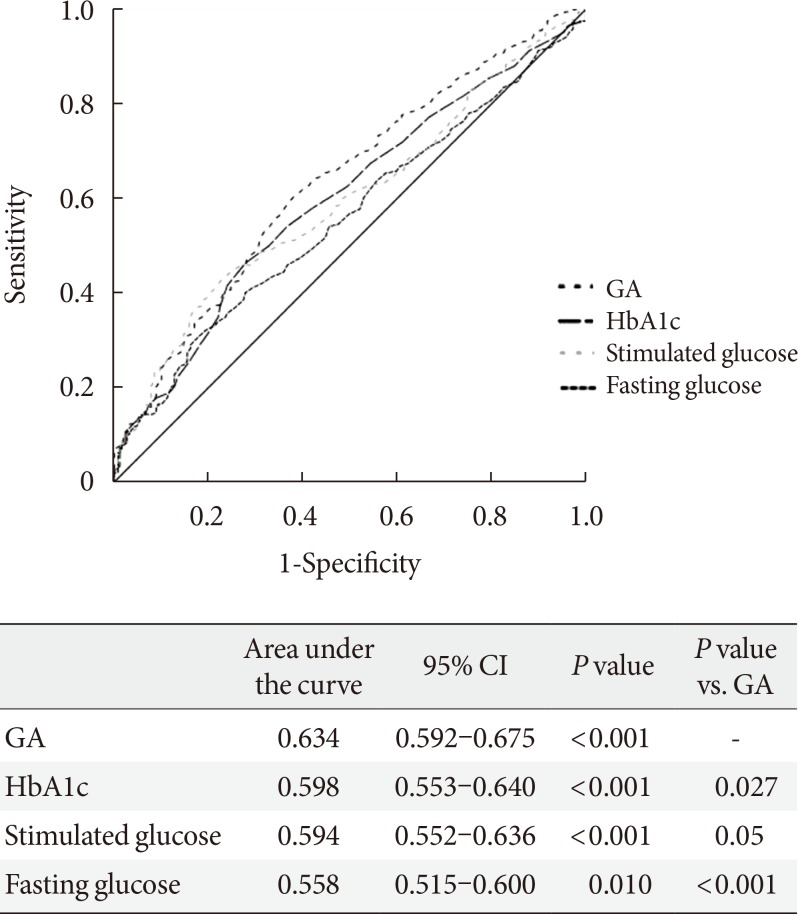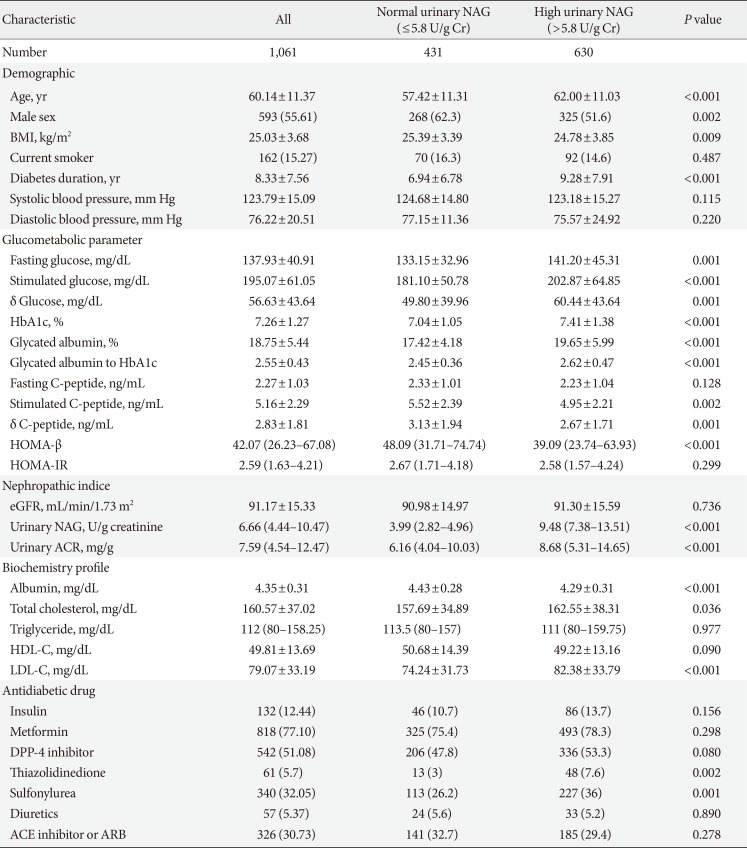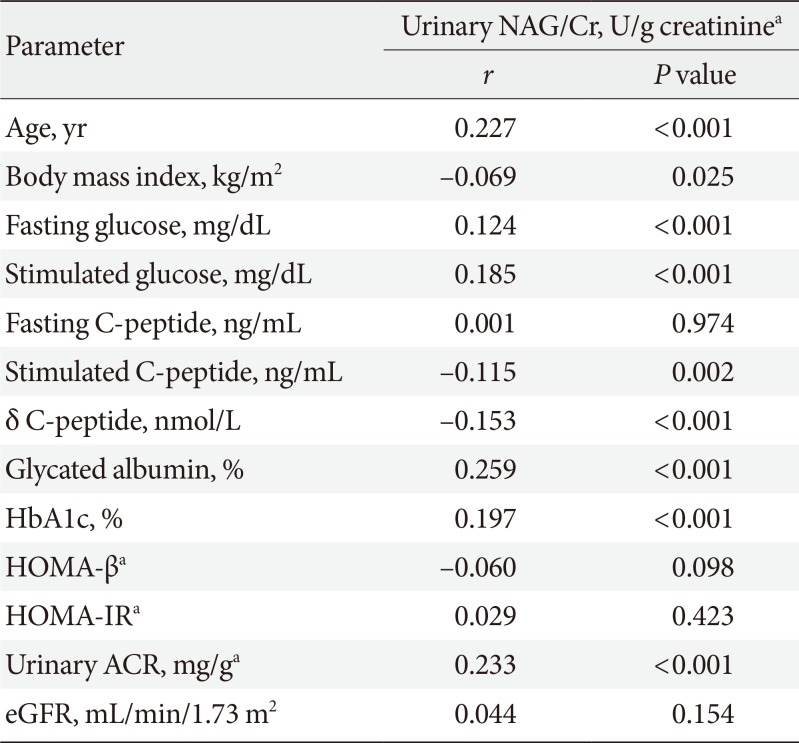1. Gilbert RE, Cooper ME. The tubulointerstitium in progressive diabetic kidney disease: more than an aftermath of glomerular injury? Kidney Int. 1999; 56:1627–1637. PMID:
10571771.

2. Fiseha T, Tamir Z. Urinary markers of tubular injury in early diabetic nephropathy. Int J Nephrol. 2016; 2016:4647685. PMID:
27293888.

3. Fu WJ, Xiong SL, Fang YG, Wen S, Chen ML, Deng RT, Zheng L, Wang SB, Pen LF, Wang Q. Urinary tubular biomarkers in short-term type 2 diabetes mellitus patients: a cross-sectional study. Endocrine. 2012; 41:82–88. PMID:
21779943.

4. Kim SR, Lee YH, Lee SG, Kang ES, Cha BS, Kim JH, Lee BW. Urinary N-acetyl-β-D-glucosaminidase, an early marker of diabetic kidney disease, might reflect glucose excursion in patients with type 2 diabetes. Medicine (Baltimore). 2016; 95:e4114. PMID:
27399115.

5. Yoshiuchi K, Matsuhisa M, Katakami N, Nakatani Y, Sakamoto K, Matsuoka T, Umayahara Y, Kosugi K, Kaneto H, Yamasaki Y, Hori M. Glycated albumin is a better indicator for glucose excursion than glycated hemoglobin in type 1 and type 2 diabetes. Endocr J. 2008; 55:503–507. PMID:
18445997.

6. Saisho Y, Tanaka K, Abe T, Kawai T, Itoh H. Lower beta cell function relates to sustained higher glycated albumin to glycated hemoglobin ratio in Japanese patients with type 2 diabetes. Endocr J. 2014; 61:149–157. PMID:
24212881.

7. Baraka-Vidot J, Guerin-Dubourg A, Dubois F, Payet B, Bourdon E, Rondeau P. New insights into deleterious impacts of in vivo glycation on albumin antioxidant activities. Biochim Biophys Acta. 2013; 1830:3532–3541. PMID:
23376313.

8. Matthews DR, Hosker JP, Rudenski AS, Naylor BA, Treacher DF, Turner RC. Homeostasis model assessment: insulin resistance and beta-cell function from fasting plasma glucose and insulin concentrations in man. Diabetologia. 1985; 28:412–419. PMID:
3899825.
9. Levey AS, Coresh J, Balk E, Kausz AT, Levin A, Steffes MW, Hogg RJ, Perrone RD, Lau J, Eknoyan G. National Kidney Foundation. National Kidney Foundation practice guidelines for chronic kidney disease: evaluation, classification, and stratification. Ann Intern Med. 2003; 139:137–147. PMID:
12859163.

10. Ouchi M, Oba K, Saigusa T, Watanabe K, Ohara M, Matsumura N, Suzuki T, Anzai N, Tsuruoka S, Yasutake M. Association between pulse wave velocity and a marker of renal tubular damage (N-acetyl-β-D-glucosaminidase) in patients without diabetes. J Clin Hypertens (Greenwich). 2015; 17:290–297. PMID:
25664677.

11. DeLong ER, DeLong DM, Clarke-Pearson DL. Comparing the areas under two or more correlated receiver operating characteristic curves: a nonparametric approach. Biometrics. 1988; 44:837–845. PMID:
3203132.

12. Yoon HJ, Lee YH, Kim SR, Rim TH, Lee EY, Kang ES, Cha BS, Lee HC, Lee BW. Glycated albumin and the risk of micro- and macrovascular complications in subjects with type 1 diabetes. Cardiovasc Diabetol. 2015; 14:53. PMID:
25975731.

13. Song SO, Kim KJ, Lee BW, Kang ES, Cha BS, Lee HC. Serum glycated albumin predicts the progression of carotid arterial atherosclerosis. Atherosclerosis. 2012; 225:450–455. PMID:
23040867.

14. Ahn JH, Yu JH, Ko SH, Kwon HS, Kim DJ, Kim JH, Kim CS, Song KH, Won JC, Lim S, Choi SH, Han K, Cha BY, Kim NH. Taskforce Team of Diabetes Fact Sheet of the Korean Diabetes Association. Prevalence and determinants of diabetic nephropathy in Korea: Korea National Health and Nutrition Examination Survey. Diabetes Metab J. 2014; 38:109–119. PMID:
24851205.

15. Holman RR, Paul SK, Bethel MA, Matthews DR, Neil HA. 10-Year follow-up of intensive glucose control in type 2 diabetes. N Engl J Med. 2008; 359:1577–1589. PMID:
18784090.

16. Action to Control Cardiovascular Risk in Diabetes Study Group. Gerstein HC, Miller ME, Byington RP, Goff DC Jr, Bigger JT, Buse JB, Cushman WC, Genuth S, Ismail-Beigi F, Grimm RH Jr, Probstfield JL, Simons-Morton DG, Friedewald WT. Effects of intensive glucose lowering in type 2 diabetes. N Engl J Med. 2008; 358:2545–2559. PMID:
18539917.
17. Vos FE, Schollum JB, Walker RJ. Glycated albumin is the preferred marker for assessing glycaemic control in advanced chronic kidney disease. NDT Plus. 2011; 4:368–375. PMID:
25984197.

18. Little RR. Usefulness of glycated albumin assay for diabetes monitoring. J Diabetes Sci Technol. 2011; 5:1463–1465. PMID:
22226266.

19. Lee EY, Lee BW, Kim D, Lee YH, Kim KJ, Kang ES, Cha BS, Lee EJ, Lee HC. Glycated albumin is a useful glycation index for monitoring fluctuating and poorly controlled type 2 diabetic patients. Acta Diabetol. 2011; 48:167–172. PMID:
21153482.

20. Pu LJ, Lu L, Xu XW, Zhang RY, Zhang Q, Zhang JS, Hu J, Yang ZK, Ding FH, Chen QJ, Lou S, Shen J, Fang DH, Shen WF. Value of serum glycated albumin and high-sensitivity C-reactive protein levels in the prediction of presence of coronary artery disease in patients with type 2 diabetes. Cardiovasc Diabetol. 2006; 5:27. PMID:
17178005.

21. Lu L, Pu LJ, Zhang Q, Wang LJ, Kang S, Zhang RY, Chen QJ, Wang JG, De Caterina R, Shen WF. Increased glycated albumin and decreased esRAGE levels are related to angiographic severity and extent of coronary artery disease in patients with type 2 diabetes. Atherosclerosis. 2009; 206:540–545. PMID:
19368923.

22. Kondaveeti SB, D K, Mishra S, Kumar R A, Shaker IA. Evaluation of glycated albumin and microalbuminuria as early risk markers of nephropathy in type 2 diabetes mellitus. J Clin Diagn Res. 2013; 7:1280–1283. PMID:
23998045.

23. Rondeau P, Bourdon E. The glycation of albumin: structural and functional impacts. Biochimie. 2011; 93:645–658. PMID:
21167901.

24. Lee YH, Kown MH, Kim KJ, Lee EY, Kim D, Lee BW, Kang ES, Cha BS, Lee HC. Inverse association between glycated albumin and insulin secretory function may explain higher levels of glycated albumin in subjects with longer duration of diabetes. PLoS One. 2014; 9:e108772. PMID:
25265016.

25. Lu CL, Ma WY, Lin YF, Shyu JF, Wang YH, Liu YM, Wu CC, Lu KC. Glycated albumin predicts long-term survival in patients undergoing hemodialysis. Int J Med Sci. 2016; 13:395–402. PMID:
27226780.

26. Selvin E, Rawlings AM, Grams M, Klein R, Sharrett AR, Steffes M, Coresh J. Fructosamine and glycated albumin for risk stratification and prediction of incident diabetes and microvascular complications: a prospective cohort analysis of the Atherosclerosis Risk in Communities (ARIC) study. Lancet Diabetes Endocrinol. 2014; 2:279–288. PMID:
24703046.

27. Gilbert RE. Proximal tubulopathy: prime mover and key therapeutic target in diabetic kidney disease. Diabetes. 2017; 66:791–800. PMID:
28325740.









 PDF
PDF ePub
ePub Citation
Citation Print
Print



 XML Download
XML Download